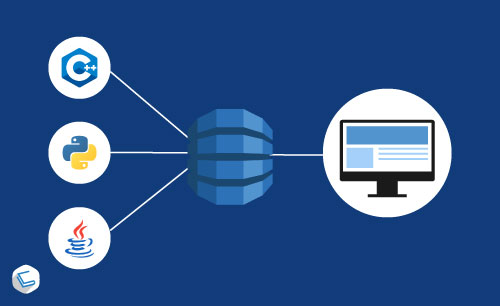
Overview
Databases are an important part of building any web application. There are various types of databases- RDBMS, NoSQL, Hybrid. Of these NoSQL is becoming increasingly popular choice for enterprises. To be a full stack developer, you have to be familiar working with databases. That is in addition to being familiar with front-end frameworks and back-end technologies. In this article, we’ll see what is a NoSQL database. We are going to discuss about AWS DynamoDB, a non-relational database by Amazon. We are going to see the uses and benefits of this database in this article.
What’s a database?
This is the first question that needs answering. It might be very basic but the rest follows this question. So, a database is essentially a collection of data that is organized and stored. It is kept easily accessible, and is used to retrieve, modify and update the existing data. The databases are what make managing huge amounts of data easy. Relational databases have been dominating the market for a long time, but it seems that the dream run is coming to an end. Getting increasing popular is its alternative- the NoSQL databases.
NoSQL databases- What is it? How does it work?
NoSQL sometimes stands for Not Only SQL, but originally meant non-relational or non-SQL databases. ‘Not Only SQL’ is to emphasize the fact that the noSQL databases also support SQL like queries. There is a need for the NoSQl database due to the changing nature of data. Initially, though the RDBMS were popular, there was a growing need to store data that were schema-less and unstructured.
road mapThis is where RDBMS had more issues with data handling and there was a need for NoSQL databases. So, now, NoSQL is increasingly used to handle big-data and is used as databases for real-time web apps. They are known for their high throughput and for loose dependence and quick indexes. This makes them the best option for IoT applications.

How does it compare it SQL databases?
In an SQL database, there is relational dependence while in NoSQL databases, there is loose dependence. While updates takes a lot of time in SQL databases, in noSQL DBs, the updates are almost instant and can be done on-demand.
For a SQL database, the performance depends on the queries and indexes whereas in a NoSQL DB, the performance depends on the network and the hardware. It is also easy to scale a NoSQL database when compared to a relational database. Additionally, the overall cost is high for the RDBMS when compared to the NoSQL DBs.
Now there are various types of NoSQL databases each with varying performance and benefits. They are Key value databases, where the data stored follows an object oriented schema.
The Document oriented databases where data is stored as documents and its flexible schema allows for higher performance. Column oriented databases which lowers input/output requirements and lowers storage requirements. The Graph databases where the focus is on the data and how it relates to other data points. The requirement of the company will decide which of the type of NoSQL database will be of more use to them.
Why learn databases for full stack web development?
To be a full stack web developer, you will need to learn front-end scripting languages, and server-side scripting languages. With the full stack web development road map you can begin to learn all the full stack development frameworks that you need to learn. The full stack requires proficiency in three layers of web development at the minimum. Those are the front-end, back-end, and the database layers. So how can you learn the set of skills?
The first thing to do is to go through various job listings and make a skills profile. Use our full stack web developer skills article to get an insight into the various skills that are required by every web developer to learn. Then you should go through the roadmap to full stack web development to know what technologies you have to learn.
You can specialize as a python full stack developer or Javascript full stack developer and many more. There is an easy way to learn these skills and that is to do a course on full stack web development offline at an institute in your city.
This will give you interaction with other aspirants and industry experts. Otherwise, you can go for an online course on full stack web development and join some online coding communities to network with other coders. Database is one of three primary layers of full stack web development and as such a must learn for being a full stack web developer.
You can learn a few NoSQL databases of different types so that you can use whichever is more beneficial to your web development project. Learn MongoDB course online if you are specializing in MEAN stack web development.
Read more: What is MEAN stack? Who is a MAN stack web developer?
Full stack frameworks, technologies and tools to learn in 2019
What are the web development trends this year?

What is AWS DynamoDB?
DynamoDB is a fully managed NoSQL database given by Amazon as a part of its Amazon Web Services. It is a key-value and document database. It has high performance and is used for very large scale applications, think internet large. According to Amazon, it handles a peak of 20 million requests per second. On an average, it is said to be capable of handling 10 trillion requests per day. It is a durable database with built-in security, it is serverless and multi regional. It also provides in-memory caching for internet scale apps.
Some interesting features of the dynamo database
It is NoSQL database. Dynamo is a set of techniques that can together form a Applications of AWS DynamoDB key-value structured storage system. AWS DynamoDB is similar to the dynamo data model. But it has a different implementation. DynamoDB has a multi master design. This means that the client is responsible for resolving issues relating to versions. Dynamo uses synchronous across data centres to achieve durability. It is cross-platform. It has proprietary license.
This means that the database is not for free consumption. This amazon product is purchased based on the rate of production which is also known as throughput. It is not sold on the basis of storage.
It also provides an automatic scaling feature. When enabled, this ensures that you have your space requirements covered whenever you need more. You can also manually request with throughput changes. Dynamo handles traffic by using solid state drives and is fairly predictable.
Many processes in DynamoDB are automated which leads to reduced overhead and issues for the coders. It integrates with Hadoop. It also supports frameworks built on Java, C++, Ruby, Python, Haskell, PHP, .NET among others.
Benefits of using AWS DynamoDB
Performance It has a very high performance. It is well known for providing single digit millisecond performance. The beauty of DynamoDB is that it manages to give this level of performance at any scale. It is very fast and offers high throughput at low latency.
Scaling Amazon DynamoDB was expressly built for infinite scalability(in theory). There is technically no limit to its scalability. If there exists an obstacle to scaling up, it is the cost of using it that has to be borne by the company.
Auto management DynamoDB is a database which automatically backup data for the customer. This back-up is meant to ensure security. The database also scales up and down as per the requirement of the client. Also, it is serverless and there is no handling of server or need to build your system for availability or tolerance which are also in-built.
Ready to use It is a managed service and there is no need for any expert to handle installation. It comes ready to use. There is no need to fret over setting it up, configuring distributed clusters, and managing the operations.
Can be used across multiple industries DynamoDB is used across multiple industries wherever there is a constantly changing volume of big data. It is used by various players like gaming industry, automotive industry and more. The popular players who have chosen this solution for their enterprises include Toyota, Samsung, and Airbnb.
Why should you use AWS DynamoDB?
Use DynamoDB where you need the web application to scale up or scale down depending on the requirements. They offer flexible micro services with AWS. They can also be reused. It improves performance. It helps focus on operational tasks and users can focus on various tasks. It is personalized and ensures smooth operations.
Conclusion Databases are a must learn for a coder to become a full stack web developer. Databases are of various types- SQL. NoSQL, Hybrid. Of these, NoSQL is currently the more popular and cost-effective type of database available. You should learn databases like MongoDB, that is a standard part of the MEAN stack web development. Additionally, popular database like AWS DynamoDB is a great skill to learn and it is a skill in great demand and is used by various players across multiple industries.
FAQs
1. What are the features of DynamoDB?
Partition Key and Partition Key and Sort Key are the two types of primary keys supported by DynamoDb. They use LSI/GSI secondary indexes to allow you to query and scan tables. In DynamoDB, data replication is possible. DynamoDB has a maximum limit of 400KB, making it ideal for storing tiny objects.
2. When should you use DynamoDB?
- You can consider DynamoDB on following conditions: Have had scalability problems with other traditional database systems.
- Are actively engaged in developing an application or service.
- Are working with an online transaction processing (OLTP) workload.
3. What are the features of DynamoDB?
Partition Key and Partition Key and Sort Key are the two types of primary keys supported by DynamoDb. They use LSI/GSI secondary indexes to allow you to query and scan tables. In DynamoDB, data replication is possible. DynamoDB has a maximum limit of 400KB, making it ideal for storing tiny objects.
4. What is DynamoDB used for?
To store key-value pairs, DynamoDb is used. Its tables are made up of things and characteristics. Each item has a unique set of characteristics. Partition Key and Partition Key and Sort Key are the two types of primary keys supported by DynamoDb.
5. Which is better MongoDB or DynamoDB?
As an integrated AWS service, DynamoDB enables developing end-to-end solutions easier. MongoDB employs JSON-like documents, while DynamoDB employs tables, items, and attributes. MongoDB provides more data types and has less size limits than DynamoDB, which supports fewer data types and has smaller item sizes.
6. Which AWS services are always free?
AWS Lambda, AWS Storage Gateway, Amazon Dynamo DB, Amazon Glacier, Amazon CloudWatch, and many other important services are all included in the Always Free offering.

Accelerate Your Career with Crampete
.png)




